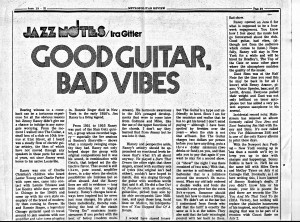Rock bottom, Returning to Louisville and the Comeback
page 1 | page 2 | page 3 | page 4 | page 5 | page 6 | page 7 | page 8| page 9|
The years that followed after 1964 were not good at all. Dad’s alcoholism worsened dramatically. It began producing personality changes including aggressive ones. My mother became increasingly fearful of him. One time he came home, found the door locked and broke the door down. On another occasion he came home from a trip completely wasted, opened his suitcase and hundreds of cockroaches came scurrying out. He was increasingly seen around the neighborhood in a drunken state. By around 1965, my mother forced him out of the house. He went back and stayed at his mother’s house in Louisville. During that time, somehow, he still managed to do a few recording dates, one with organist Shirley Scott and another with drummer Danny Richmond. The latter was an interesting affair. Jimmy was actually called on to play something resembling rock guitar.
Jimmy did what he could to try to beat alcoholism, but it was just something he couldn’t really lick for more than six months. He would be fine, write nice letters, get some gigs and then end up right where he was before. Attempts were made to reconcile with my mother but it just couldn’t work anymore without the promise of kicking the habit. Back in Louisville, he rekindled his childhood friendship with pianist Ola Miracle, who eventually became his companion. It was through Ola’s management that the concert for the Louisville Jazz Society in 1967 took place. This material would eventually comprise the second side of the Strings and Swings album. The guitar work on this album was arguably some of Jimmy’s finest playing ever captured. Those who were in attendance for the event said that Jimmy’s playing was simply stunning. On board for the date were Charles Mingus alumnus, tenor-man Bobby Jones, the very talented Bobby Lam on piano (who would later take his own life), bassist Jack Brengle and drummer John Roy.
Aside from this one recorded concert, there would be no more recordings or trips back to New York for work for several years. Between the nonexistent music scene, his battle with alcoholism, the loss of his family and living at his mother’s house, life was not turning out great for the once heralded master of jazz guitar. My grandmother did what she could to be a taskmaster and keep him off the bottle, but eventually he would go out on another binge. It was my unfortunate fate to have gotten a heavy dose of this side of my father in my early life.
I spent many summers at my grandmother’s house and it was always hit or miss. As soon as I finally could give in and trust that my father had gotten past his illness, he would fall back in. He would get into car accidents or get picked up by the police. I recall when the car keys were kept from him, he took to riding a 40-year-old bike to the liquor store, only to fall flat on his face in front of the entire neighborhood of kids. The shame of these things was hard for me to get over for a long time. He would just drink himself into submission and no one or nothing could stop him, save jail. After a particularly bad alcoholic binge, my grandmother forced him out of the house and into a clinic to deal with his severe alcoholism. I visited him at the clinic.
At the urging of family and friends he, joined A.A. Although he never truly got with the whole recovery culture of A.A and their methods, it nevertheless seemed to help him to remain sober longer. Unfortunately, Jimmy was doing very little besides whatever local gigs he could manage and occasional teaching up until 1972. Jazz generally had moved off the radar as well. But still, through it all, everyone knew he was still one of the greatest living jazz guitarists. If only he could just get out of this hell he had made for himself.
1972 finally marked Jimmy’s triumphant return to New York at a nightclub called the The Guitar. He played there for a month and was in great shape throughout. Jimmy roomed with fellow guitarists and friends, Howie Collins and Attilla Zoller. Stalwart bassists, Michael Moore and Linc Milliman, were on hand for the gigs and many musicians showed up to witness the Raney magic again. Old cohort, Stan Getz showed up and sat in for a tune but the owner refused to let him play further due to cabaret license laws. While it was not the greatest club to play in, this gig opened the door to other N.Y. clubs and in general, would reignite Jimmy’s career in the 70’s. Ira Gitler’s review of the club and the music is at above left. Gitler’s assessment of the club’s somewhat fan unfriendly policies (drink charges, minimums, etc) would pretty much become commonplace and standard for high profile jazz clubs in New York City.
page 1 | page 2 | page 3 | page 4 | page 5 | page 6 | page 7 | page 8| page 9|
